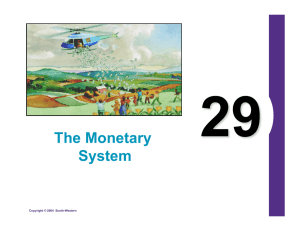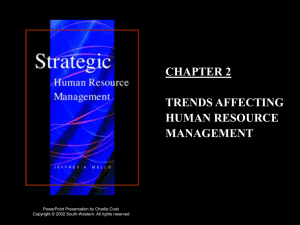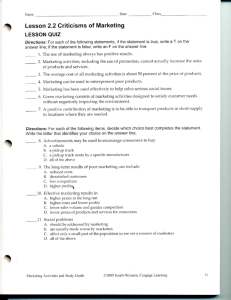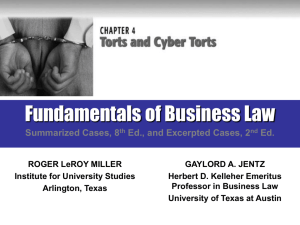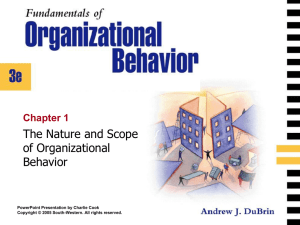Services and Nonprofit Organization Marketing
advertisement
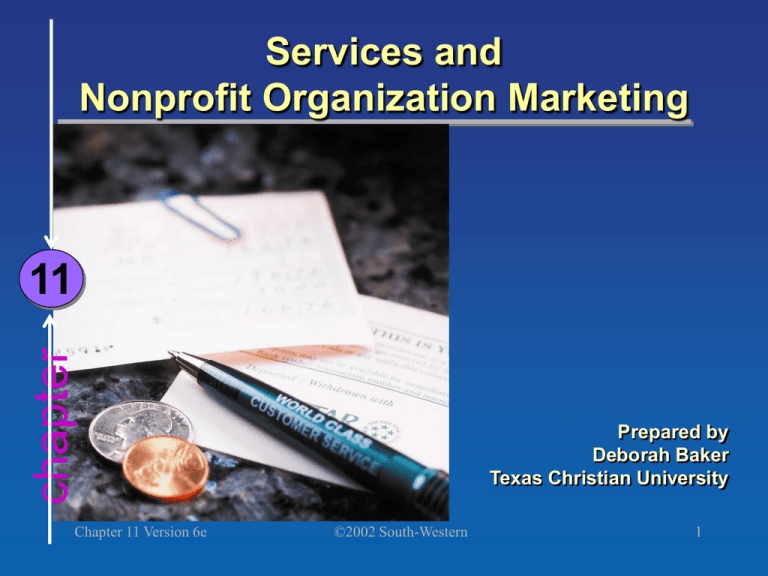
Services and Nonprofit Organization Marketing chapter 11 Chapter 11 Version 6e Prepared by Deborah Baker Texas Christian University ©2002 South-Western 1 Learning Objectives 11 2. Discuss the differences between services and goods. chapter 1. Discuss the importance of services to the economy. 3. Describe the components of service quality and the gap model of service quality. Chapter 11 Version 6e ©2002 South-Western 2 Learning Objectives (continued) 4. Explain why services marketing is important to manufacturers. 5. Develop marketing mixes for services. 11 chapter 6. Discuss relationship marketing in services. 7. Explain internal marketing in services. Chapter 11 Version 6e ©2002 South-Western 3 Learning Objectives (continued) 8. Discuss global issues in services marketing. 9. Describe nonprofit organization marketing. chapter 11 10.Explain the unique aspects of nonprofit organization marketing. Chapter 11 Version 6e ©2002 South-Western 4 1 Learning Objective Discuss the importance of services to the economy. Chapter 11 Version 6e ©2002 South-Western 5 1 Service The result of applying human or mechanical efforts to people or objects. Chapter 11 Version 6e ©2002 South-Western 6 1 The Importance of Services 79% of workers are in service sector Services account for 76% of U.S. GDP Service occupations will be responsible for all job growth through 2005 Chapter 11 Version 6e ©2002 South-Western 7 2 Learning Objective Discuss the differences between services and goods. Chapter 11 Version 6e ©2002 South-Western 8 2 How Services Differ from Goods Intangibility Characteristics That Distinguish Services Inseparability Heterogeneity Perishability Chapter 11 Version 6e ©2002 South-Western 9 2 Characteristics of Services Intangibility Inseparability Heterogeneity Perishability Chapter 11 Version 6e Services that cannot be touched, seen, tasted, heard, or felt in the same manner as goods. A characteristic of services that allows them to be produced and consumed simultaneously. A characteristic of services that makes them less standardized and uniform than goods. A characteristics of services that prevents them from being stored, warehoused, or inventoried. ©2002 South-Western 10 3 Learning Objective Describe the components of service quality and the gap model of service quality. Chapter 11 Version 6e ©2002 South-Western 11 3 Service Quality Reliability Responsiveness Components for Evaluating Service Quality Assurance Empathy Chapter 11 Version 6e ©2002 South-Western Tangibles 12 3 Components of Service Quality Reliability The ability to perform the service right the first time. Responsiveness The ability to provide prompt service Assurance The knowledge and courtesy of employees. Empathy Caring, individualized attention to customers. Tangibles Chapter 11 Version 6e The physical evidence of a service. ©2002 South-Western 13 3 The Gap Model of Service Quality Customer Expected Service GAP 5 Perceived Service Provider GAP 1 Service Delivery GAP 4 Communication with Customers GAP 3 Quality Specifications GAP 2 Chapter 11 Version 6e Mgmt perception ©2002 South-Western 14 4 Learning Objective Explain why services marketing is important to manufacturers. Chapter 11 Version 6e ©2002 South-Western 15 Services Marketing in Manufacturing Chapter 11 Version 6e ©2002 South-Western 4 16 5 Learning Objective Develop marketing mixes for services. Chapter 11 Version 6e ©2002 South-Western 17 5 Marketing Mixes for Services People Processing Product (Service) Strategy Possession Processing Information Processing Chapter 11 Version 6e ©2002 South-Western 18 Core and Supplementary Services Core Service The more basic benefit the consumer is buying. Supplementary Service A group of services that support or enhance the core service. Chapter 11 Version 6e ©2002 South-Western 19 5 Core and Supplementary Services Problem solving Billing statements Tracing Chapter 11 Version 6e Advice and information Overnight transportation and delivery of packages Documentation ©2002 South-Western Order taking Supplies Pickup 20 5 5 Mass Customization A strategy that uses technology to deliver customized services on a mass basis. Chapter 11 Version 6e ©2002 South-Western 21 5 High Customized Focus Mass Customization Standardized Focus Low Customization Mass Customization High Chapter 11 Version 6e Cost ©2002 South-Western Low 22 5 Service Mix Strategy Determine what new services to introduce Determine target market Decide what existing services to maintain and/or eliminate Chapter 11 Version 6e ©2002 South-Western 23 5 Distribution Strategy Issues Convenience Number of Outlets Focus for Distribution Strategies Direct vs. Indirect Distribution Location Scheduling Chapter 11 Version 6e ©2002 South-Western 24 5 Promotion Strategy Issues Stress tangible cues Service Promotion Strategies Use personal information sources Create a strong organizational image Engage in postpurchase communication Chapter 11 Version 6e ©2002 South-Western 25 5 Price Strategy Define unit of service consumption Pricing Challenges Determine if multiple elements are “bundled” Trends have made pricing an active component Chapter 11 Version 6e ©2002 South-Western 26 5 Pricing Objectives Categories of Pricing Objectives PatronageOriented Pricing Revenue-Oriented Pricing OperationsOriented Pricing Chapter 11 Version 6e ©2002 South-Western 27 6 Learning Objective Discuss relationship marketing in services. Chapter 11 Version 6e ©2002 South-Western 28 Relationship Marketing in Services Three Levels of Relationship Marketing 6 Level 3 Financial, Social, Structural Level 2 Financial, Social Level 1 Financial Chapter 11 Version 6e ©2002 South-Western 29 Relationship Marketing in Services Level Type of bond Degree of service customization Main element of marketing mix One Financial Low Two Financial and social Medium Personal communication Three Financial, social, and structural Medium to high Service delivery Chapter 11 Version 6e Price ©2002 South-Western 6 Potential for long-term advantage over competitors Low Medium High 30 7 Learning Objective Explain internal marketing in services. Chapter 11 Version 6e ©2002 South-Western 31 7 Internal Marketing Treating employees as customers and developing systems and benefits that satisfy their needs. Chapter 11 Version 6e ©2002 South-Western 32 7 Internal Marketing Activities Competing for Talent Offering a Vision Empowerment Training Employees Rewarding Performance Stressing Teamwork Knowing Employees’ Needs Internal Marketing Activities Chapter 11 Version 6e ©2002 South-Western 33 8 Learning Objective Discuss global issues in services marketing. Chapter 11 Version 6e ©2002 South-Western 34 Global Issues in Services Marketing 8 Financial Construction Engineering Insurance U.S. is world’s largest exporter of services Chapter 11 Version 6e Restaurant Chains ©2002 South-Western 35 9 Learning Objective Describe nonprofit organization marketing. Chapter 11 Version 6e ©2002 South-Western 36 9 Nonprofit Organization Marketing An organization that exists to achieve some goal other than the usual business goals of profit, market share, or return on investment. Chapter 11 Version 6e ©2002 South-Western 37 9 Nonprofit Organizations Government Private Museums Theaters Schools Nonprofit Organizations Churches Other Non-government Chapter 11 Version 6e ©2002 South-Western 38 9 Nonprofit Organization Marketing Market intangible products Shared Characteristics with Service Organizations Production requires customer’s presence Services vary greatly Services can not be stored Chapter 11 Version 6e ©2002 South-Western 39 Nonprofit Organization Marketing Activities 9 Identify Desired Customers Specify Objectives Develop, manage, eliminate programs/services Set prices Schedule events Chapter 11 Version Communicate 6e ©2002 through South-Western advertising/PR 40 Learning Objective 10 Explain the unique aspects of nonprofit organization marketing. Chapter 11 Version 6e ©2002 South-Western 41 Unique Aspects of Nonprofit 10 Organization Marketing Strategies Unique Aspects of Marketing of Nonprofit Organizations Market Objectives Marketing Mixes Target Markets Chapter 11 Version 6e ©2002 South-Western 42 10 Market Objectives Provide Services to: Users Payers Appointed officials Donors Media Politicians General Public Chapter 11 Version 6e ©2002 South-Western 43 10 Target Markets Apathetic or strongly opposed targets Pressure to adopt undifferentiated segmentation Unique Issues of Nonprofit Organizations Complementary positioning Chapter 11 Version 6e ©2002 South-Western 44 Product Decisions Benefit Complexity 10 Distinctions between Business and Nonprofit Organizations Weak Benefit Strength Low Involvement Chapter 11 Version 6e ©2002 South-Western 45 10 Promotion Decisions Professional Volunteers Nonprofit Organization Promotion Decisions Sales Promotion Activities Public Service Advertising Licensing Chapter 11 Version 6e ©2002 South-Western 46 10 Pricing Decisions Pricing Objectives Nonfinancial Prices Characteristics Distinguishing Pricing Decisions of Nonprofit Organizations Chapter 11 Version 6e Indirect Payment Separation Between Payers and Users Below-Cost Pricing ©2002 South-Western 47
